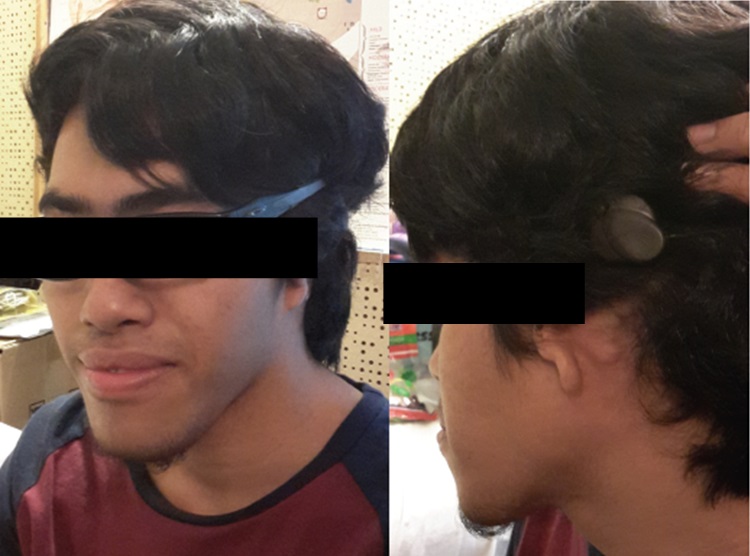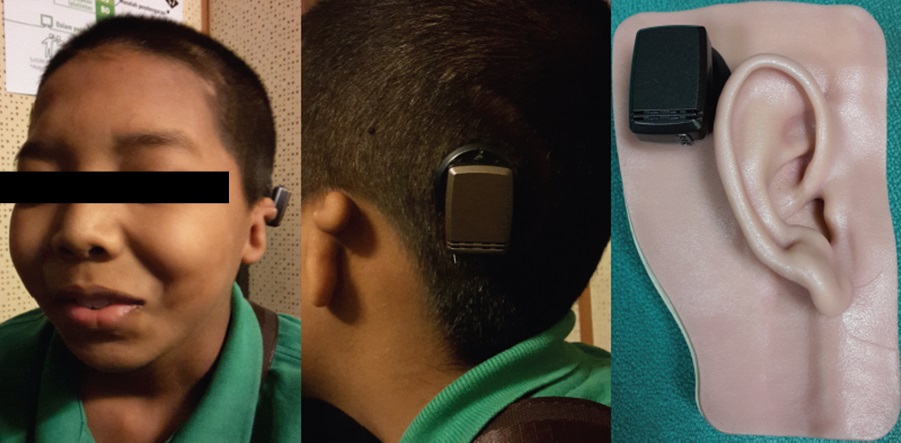Sound can be transmitted or perceived with our human ears in two ways, either through air conduction or bone conduction. In a normal individual, sound passes through the ear canal and hits the eardrum, creating a mechanical vibration through the middle ear bones (Ossicles). The mechanical vibrations is then transmitted to the cochlear, where the vibrations is then converted to electrical energy (impulses) which is passes on to the nerves and reaches the brain for interpretation. Sound can also be perceived when there is auditory or mechanical stimulation on the skull bone. The vibrations on the skull bone stimulate the cochlear directly generating electrical impulses bypassing the external and middle ear. This type of sound transmission is known as bone conduction.
Hearing Aids
Hearing aid is an electrical device invented to amplify sound and more importantly speech, for effective communication. Hearing aids are divided into two categories based on their mechanical functions, which are the conventional air conduction hearing aid and also the bone conduction hearing aid.
Bone Conduction Hearing Aids
Bone conduction hearing aid (BCHA) is a hearing device used to convert the sound energy into vibration. Sound is then transmitted through the skull (Bone Conduction) into the cochlear or inner ear bypassing the pathological external and middle ear. (Håkansson et al, 1985; Stenfelt & Goode, 2005a)
How It’s Work?
Bone conduction hearing aid functions to detect sound waves through the microphones and then transforms the sound energy into vibrations. The bone conductor/ oscillator which was placed on the skull or mastoid bone will vibrate, creating sound energy directly into the inner ear, by passing any pathology of the external and middle ear.
Indications
- Patient with conductive/ mixed hearing loss
- Patients who are born with deformity of the outer and / or middle ear (congenital malformation of external and middle ear) such as Microtia, Anotia and Canal atresia or stenosis, which might preclude the usage of conventional air conduction hearing aid. These conditions causes the inability for the coupling of the hearing aids mould to the ear canal (Frenzel et al, 2009)
- Patients who suffers from persistent prolonged ear infection with discharging ear (watery or pus form the ear), or have undergone some major ear surgeries in which with continuous usage of the conventional air conduction hearing aid with occluded ear mould may further exacerbate the outer and middle ear infections. In cases of extensive destruction of the middle ear bones (ossicular chain) or severe stiffening of the middle ear bones (otosclerosis) it is even more unlikely to use the air conduction hearing aid as the conditions affecting the middle ear or integrity of the ossicular chain that may require greater amplification than a air hearing aid can provide (Colletti et al, 2009).
- Single sided deafness (SSD) (Dumper et al, 2009) SSD are patients who suffer from deafness (unilateral sensorineural deafness) on one ear, while the other ear has normal hearing. It is a condition where the non-functioning ear does not receive any clinical benefit from traditional amplification. Patient will then be affected by sound source location and difficulties in speech intelligibility in the presence of background noise.
Contraindications
Patient with sensorineural hearing loss, will benefit from conventional air conduction hearing aid.
- BCHA has limited power output and its causes distortion when reaching high level of stimulation.
- BCHA stimulates the better cochlear where it does not correspond to the side its’ microphone pick up the sound. Thus, it cannot give the user good localization or spatial ability.
- BCHA causes discomfort at pressure points where the bone vibrator is placed.
Types of Bone Conduction Hearing Aids
There are various types of BCHA available in the market.
- Body worn hearing aid with oscillator
- Behind the ear with oscillator
- Spectacle aid with oscillator
- Bone conduction hearing aid with soft band
- SoundBite Dental Hearing System
Bone Conduction Implant and How It Works
- Bone Anchored Hearing Aid (BAHA)
BAHA is a bone conduction implant device, where a small piece of titanium is surgically implanted onto the bone behind our ear with an abutment exposed on the surface of the skin. The sound processor is fitted onto the abutment and sound vibration is transmitted via the abutment to the implant, which directs the sound vibrations through the bone to stimulate the inner ear. - Bone Bridge implant system
An active transcutaneous bone conduction implant system, has an implanted transducer in direct contact with the bone. The Audio processor embraced with microphones, battery and digital signal processor, is attached on the intact skin via magnetics. Audio processor picks up sound and is converted into electrical signal and then transmitted to the implant system via the skin, signal convertor of the implant and then covert the electrical signal into a mechanical vibration that vibrates the skull to stimulate the inner ear.

- Bone Anchored Hearing Aid Attract system (BAHA Attract System)
A passive transcutaneous device that has an external audio processor that is attached with the implanted magnet and titanium implant. The audio processor consists of a microphones, a battery and a transducer; the sound processor is then attached to a sound processor magnet. Sound travels as vibrations from the processor via the magnets to the implant, which then directs the vibrations through the bone to stimulate the inner ear.

Advantages and Disadvantages of Bone Conduction Implant
Advantages
- Direct transmission of vibrational energy to the skull, using it without headband, soft band, spectacle etc.
- More cosmetically appealing
- Implant is placed below the skin, leaving the skin intact, ensures lower risk of skin complications (For BAHA attract and Bone Bridge only)
Disadvantages
- The device needs surgical implantation with a low risk of rejection by the individual.
- Skin complication or infection around the abutment (For BAHA).
Disclaimer
This article is for a general and basic reference only; it cannot be use as a guide for an individual treatment procedure or options. Please seek advice from your medical practitioner or Audiologist about your treatment for hearing loss.
References
- Colletti V., Carner M. & Colletti L. 2009. TORP vs. round window implant for hearing restoration of patients with extensive ossicular chain defect. Acta Otolaryngol, 129, 449–452.
- Dumper J., Hodgetts B., Liu R. & Brandner N. 2009. Indications for bone- anchored hearing aids: Afunctional outcomes study. J Otolaryngol Head Neck Surg, 38(1), 96–105.
- Frenzel H., Frauke H., Beltrame M., Steffen A., Schonweiler R. et al. 2009. Application of the vibrant soundbridge to unilateral osseous atresia cases. The Laryngoscope, 119, 67–74.
- Håkansson B., Tjellström A., Rosenhall U. & Carlsson P. 1985. The boneanchored hearing aid: Principal design and a psychoacoustical evaluation. Acta Otolaryngol, 100, 229–239.
- Roberta Marino, Nicola Linton, Robert H. Eikelboom, Elle Statham & Gunesh P. Rajan (2013) A comparative study of hearing aids and round window application of the vibrant sound bridge (VSB) for patients with mixed or conductive hearing loss, International Journal of Audiology, 52:4, 209-218
- Stenfelt S. & Goode R.L. 2005a. Bone-conducted sound: Physiological and clinical aspects. Otol Neurotol 26(6), 1245–61.
| Last Reviewed | : | 11 April 2017 |
| Writer | : | Tan I Dee |
| Accreditor | : | Rohaizatul bt. Mat Yaacob |







